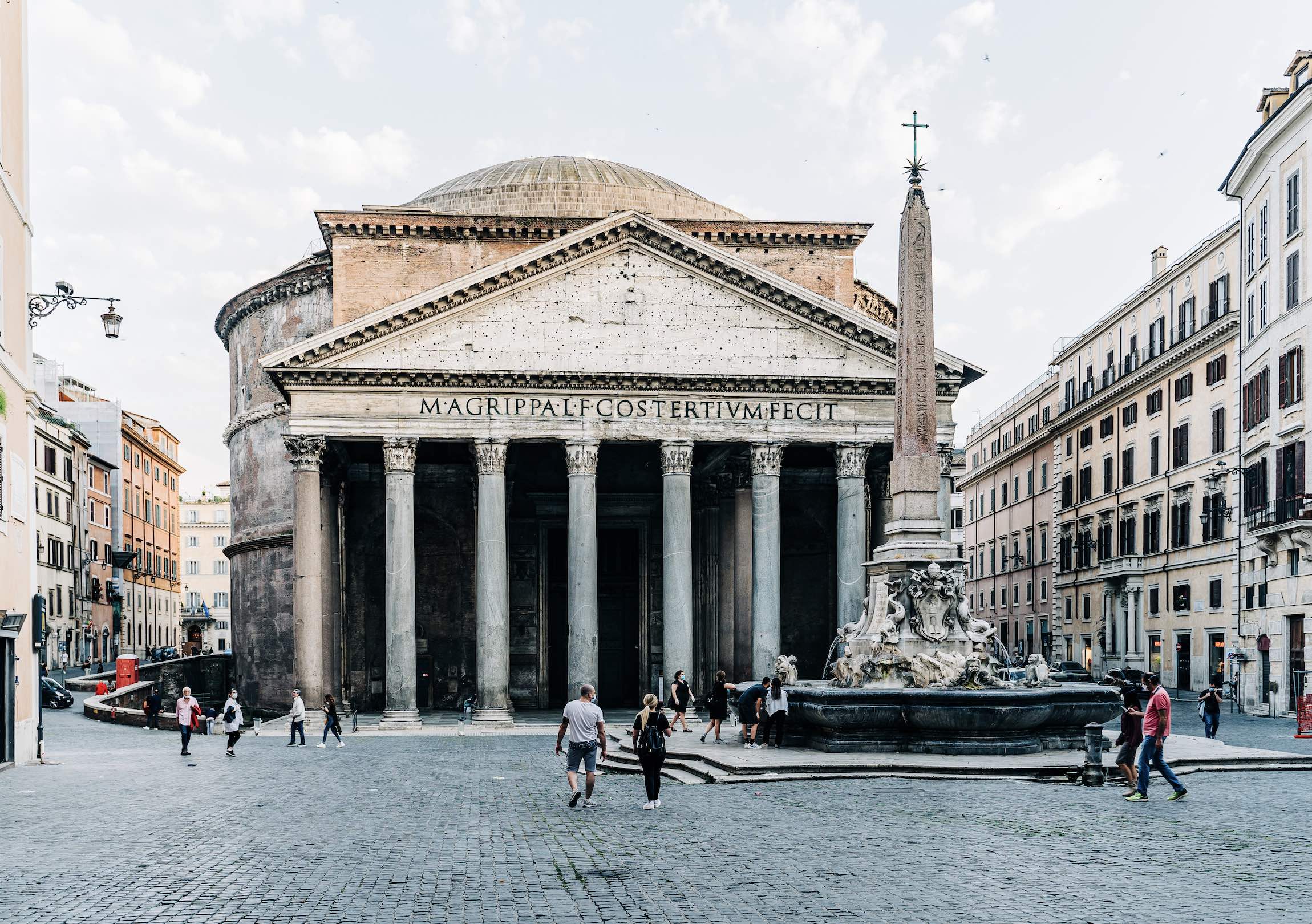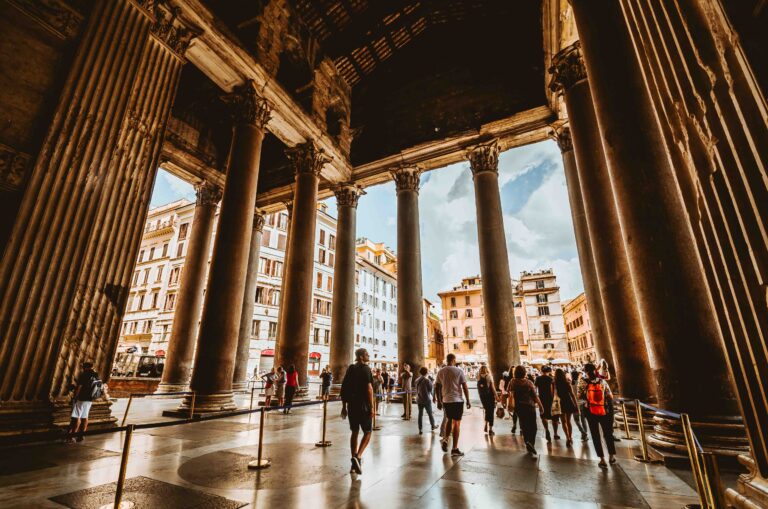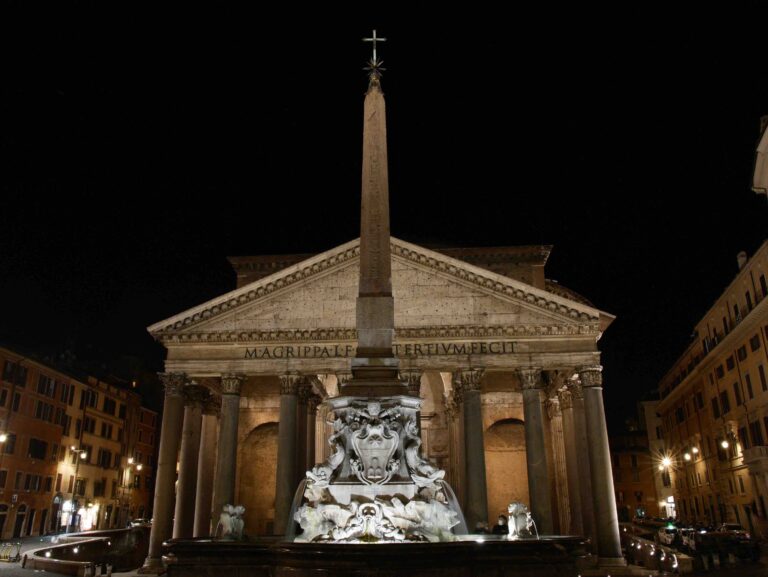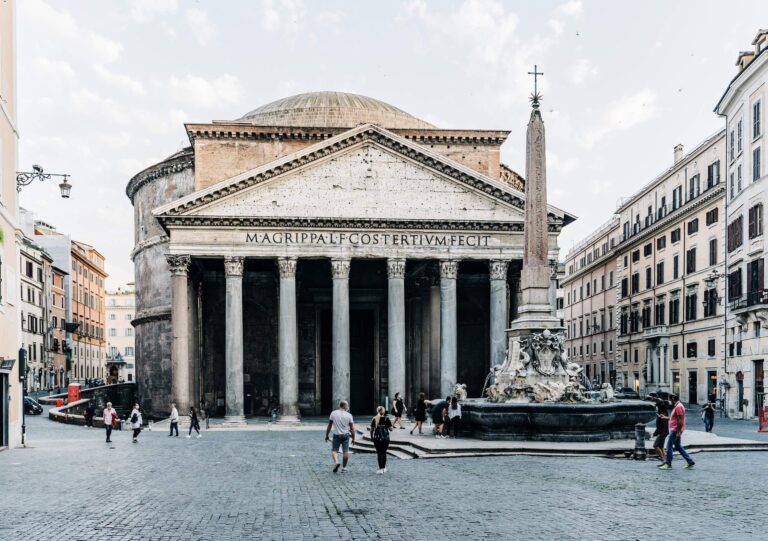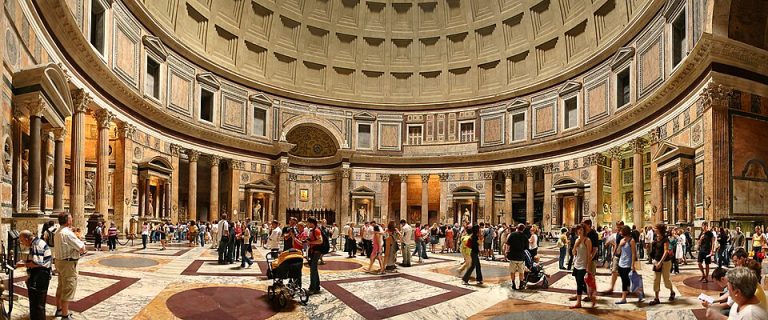There’s something magical about stepping into a place that has stood for nearly two thousand years. The moment you walk into the Pantheon in Rome, you feel it, not just the grandeur of its architecture, but the weight of history, the whispers of ancient voices, and the awe that has drawn millions through its doors.
Whether you’re a history lover, an architecture enthusiast, or simply curious about Rome’s most iconic landmarks, visiting the Pantheon is an experience that stays with you. It’s not just another stop on a sightseeing tour. It’s a moment of connection, with the past, with beauty, and with the soul of the Eternal City.
In this guide, we’ll walk you through everything you need to know before visiting the Pantheon in Rome. From its fascinating history to practical tips for your trip, we’ve got you covered. Whether you’re planning your first visit or returning for a deeper look, this article will help you make the most of your time at one of the world’s greatest architectural wonders.
A Brief History of the Pantheon
Before you stand beneath its massive dome, it helps to understand what makes the Pantheon so special. Originally built around 27 BC by Marcus Agrippa, the structure we see today was rebuilt by Emperor Hadrian in 125 AD after fire damaged the original. You’ll still see Agrippa’s name proudly inscribed on the front, a nod to its roots.
The Pantheon was designed as a temple to all Roman gods, hence the name, which means “all gods” in Greek. But its story didn’t end with the fall of the Roman Empire. In the 7th century, it was converted into a Christian church, which helped preserve it through centuries of change and conflict. Today, it’s officially known as the Basilica of St. Mary and the Martyrs, though most people still call it simply “the Pantheon.”
What truly sets the Pantheon apart is its architecture. The dome, still the largest unreinforced concrete dome in the world, is a marvel of engineering. At its center is the oculus, a circular opening that lets sunlight stream in and rain fall through. This design wasn’t just practical; it was symbolic, connecting the heavens to the earth.
Inside, you’ll find tombs of notable figures like the painter Raphael and Italian kings Victor Emmanuel II and Umberto I. The Pantheon is not just a monument, it’s a living piece of history, a place where ancient Rome meets modern Italy.
Why Visit the Pantheon?
You might be wondering, what makes the Pantheon so special compared to other ancient sites in Rome? The answer is simple: it’s one of the best-preserved monuments from ancient Rome, and it’s still in use today. That alone is remarkable.
Visiting the Pantheon in Rome gives you a chance to see a structure that has survived wars, invasions, and centuries of change. It’s not just a relic, it’s a living building. You can walk through its massive bronze doors, stand beneath the world-famous dome, and feel the sunlight pour in through the oculus. It’s a moment that feels both timeless and deeply personal.
The Pantheon is also home to the tombs of some of Italy’s most important figures, including the artist Raphael and two former kings. It’s a place where art, history, and spirituality meet. Whether you’re snapping photos, attending mass, or simply soaking in the atmosphere, the experience is unforgettable.
And here’s a bonus: it’s centrally located, so it’s easy to include in any Rome itinerary. You’ll find it just a short walk from Piazza Navona, the Trevi Fountain, and other must-see spots.
Best Time to Visit the Pantheon
Rome is beautiful year-round, but timing your visit to the Pantheon can make a big difference. If you want to avoid crowds and enjoy a peaceful experience, early mornings are your best bet. The light streaming through the oculus around 9 to 10 AM creates a stunning effect that photographers and architecture lovers adore.
Spring and fall are ideal seasons for visiting Rome. The weather is pleasant, and the city isn’t as packed with tourists as it is in summer. April, May, September, and October offer a great balance of sunshine and manageable crowds.
If you’re visiting the Pantheon in Rome during summer, be prepared for heat and longer lines. It’s still worth it, but bring water, wear light clothing, and consider booking a skip-the-line tour to save time.
Sundays and religious holidays can be busier, especially if you’re hoping to attend mass. On those days, the Pantheon functions more as a church than a tourist site, so access may be limited. If you’re interested in the spiritual side of the building, attending a service can be a meaningful experience, but check the schedule ahead of time.
How to Get to the Pantheon
Getting to the Pantheon in Rome is surprisingly easy, especially since it’s right in the heart of the city’s historic center. If you’re staying nearby, walking is the best option. You’ll enjoy charming cobblestone streets, lively piazzas, and maybe even stumble upon a gelato shop or two along the way.
The Pantheon sits in Piazza della Rotonda, just a short stroll from other famous landmarks like Piazza Navona and the Trevi Fountain. If you’re coming from farther out, Rome’s public transportation system can get you there without much hassle.
The closest metro stop is Barberini (Line A), and from there it’s about a 10-minute walk. Several bus lines also stop nearby, including routes 30, 40, 62, and 64. If you’re using a taxi or ride-share, just ask for “Pantheon” and they’ll know exactly where to take you.
For those who love exploring on foot, consider joining a walking tour that includes the Pantheon. It’s a great way to learn about the surrounding area and get context before stepping inside.
Pantheon Tickets and Entry Info
For many years, visiting the Pantheon in Rome was free. But as of mid-2023, the Italian government introduced a small entrance fee to help preserve the site. Don’t worry, it’s still very affordable, and the experience is worth every cent.
General admission tickets cost around €5 for adults, with reduced prices for EU citizens under 25 and free entry for children under 18. If you’re planning to visit multiple sites in Rome, look into combo passes that include the Pantheon along with places like Castel Sant’Angelo or the Colosseum.
You can buy tickets online through the official website or from authorized tour providers. Booking in advance is a smart move, especially during peak travel seasons. It helps you skip the line and guarantees your spot.
If you prefer a deeper experience, guided tours are available and often include skip-the-line access. These tours usually last about an hour and offer fascinating insights into the building’s history, architecture, and hidden details you might miss on your own.
Keep in mind that the Pantheon is still an active church. On Sundays and during religious services, entry may be restricted or free for worshippers. If you’re hoping to attend mass, check the schedule ahead of time and arrive early.
Guided Tours: Are They Worth It?
If you’re the kind of traveler who loves stories behind the stones, a guided tour of the Pantheon is absolutely worth it. While the building itself is impressive, having someone walk you through its history, symbolism, and hidden details brings the experience to life in a whole new way.
Most guided tours of the Pantheon last about an hour and include fascinating insights you won’t find on the signs. You’ll learn how the dome was built without modern tools, why the oculus was left open, and how the building’s design reflects ancient Roman beliefs. Some guides even point out architectural quirks and lesser-known facts that make you see the monument with fresh eyes.
There are several types of tours to choose from. Private tours offer a more personalized experience, while group tours are budget-friendly and still informative. Audio guides are also available if you prefer to explore at your own pace but still want some context.
Many tour companies offer combo packages that include the Pantheon along with other nearby sites like Piazza Navona or the Church of San Luigi dei Francesi. These can be a great way to maximize your time and deepen your understanding of Rome’s rich history.
Whether you’re a first-time visitor or returning for a deeper dive, a guided tour adds value and meaning to your visit. It turns a beautiful building into a story you’ll remember long after you’ve left.
What to See Inside the Pantheon
Once you step through the massive bronze doors, the real magic begins. The interior of the Pantheon is breathtaking, and there’s plenty to take in, even if you’re just popping in for a quick look.
The first thing you’ll notice is the dome. It’s massive, perfectly symmetrical, and still holds the record as the largest unreinforced concrete dome in the world. The oculus at the center lets in natural light, creating a dramatic spotlight effect that shifts throughout the day. On rainy days, you might even see drops falling through, it’s all part of the design.
Look down and you’ll see the patterned marble floor, which has been carefully restored to reflect its original layout. The geometric shapes and rich colors add to the sense of harmony and balance that defines the space.
Around the circular walls are several chapels and altars, each with its own story. One of the most visited spots is the tomb of Raphael, the Renaissance painter whose work helped shape Western art. His resting place is marked by a simple inscription and a statue of the Madonna.
You’ll also find the tombs of Italian kings Victor Emmanuel II and Umberto I, adding a layer of national pride to the building’s legacy. These monuments are beautifully crafted and often adorned with flowers from visitors.
Don’t forget to look up, down, and all around. The Pantheon is full of details, from Latin inscriptions to hidden symbols, that reflect its long and layered history. Take your time, soak it in, and let yourself be transported.
Tips for a Smooth Visit
Visiting the Pantheon in Rome is pretty straightforward, but a few smart tips can make your experience even better. First, arrive early. The crowds tend to build up by late morning, especially during peak travel seasons. If you want to enjoy the space quietly and take great photos, aim to get there right after it opens.
Dress comfortably but respectfully. Since the Pantheon is still a functioning church, modest clothing is recommended, especially if you plan to attend mass. Light layers are perfect for Rome’s changing weather, and good walking shoes are a must.
Photography is allowed, but flash and tripods are not. Be mindful of other visitors and avoid blocking pathways while snapping pictures. If you’re using a phone, take a moment to look up from the screen and really absorb the beauty around you.
Accessibility is fairly good. The entrance is flat, and there’s space to move around inside, though some areas may be a bit tight during busy hours. If you have mobility concerns, check ahead for updated access info or consider joining a guided tour that accommodates special needs.
There are no restrooms inside the Pantheon, but you’ll find public facilities nearby in Piazza della Rotonda. It’s also a great spot to grab a coffee or gelato after your visit. Just be aware that prices can be higher in tourist-heavy areas, so check menus before ordering.
Nearby Attractions and Itinerary Ideas
One of the best things about visiting the Pantheon in Rome is how close it is to other incredible sights. You can easily build a half-day or full-day itinerary around it without feeling rushed.
Start with a stroll to Piazza Navona, just five minutes away. This lively square is known for its fountains, street artists, and vibrant atmosphere. From there, head to Campo de’ Fiori for a taste of local life, especially if you’re visiting in the morning when the market is in full swing.
Don’t miss the Church of San Luigi dei Francesi, home to stunning Caravaggio paintings that are free to view. It’s a quiet gem just around the corner from the Pantheon and well worth a stop.
If you’re up for more walking, the Trevi Fountain is about 10 minutes away. Toss a coin in and make a wish, it’s a classic Rome tradition. You can also continue on to the Spanish Steps or even the Roman Forum if you’re feeling ambitious.
For a relaxing break, grab a seat at one of the cafés in Piazza della Rotonda and enjoy the view of the Pantheon’s majestic façade. It’s a great spot to reflect on your visit and soak in the energy of the city.
FAQs About Visiting the Pantheon in Rome
Is the Pantheon free to enter?
Not anymore. As of 2023, there’s a small entrance fee for general visitors. However, entry remains free during religious services and for certain age groups and EU citizens under 18 or over 65.
Can I attend mass at the Pantheon?
Yes. The Pantheon is still an active church, and mass is held regularly. If you’re interested in attending, check the schedule ahead of time and arrive early to find a seat.
Is the Pantheon wheelchair accessible?
Mostly, yes. The entrance is flat and the interior is spacious, though it can get crowded. If you have specific accessibility needs, it’s best to contact the site or join a guided tour that accommodates mobility concerns.
Are there restrooms inside?
No, but public restrooms are available nearby in Piazza della Rotonda. Many cafés in the area also offer facilities for customers.
How long should I spend at the Pantheon?
Most visitors spend about 30 to 60 minutes inside. If you’re taking a guided tour or want to explore nearby attractions, plan for at least two hours.
Can I take photos inside?
Yes, photography is allowed, but flash and tripods are not. Be respectful of others and avoid taking pictures during mass or religious services.
Final Thought: Let the Pantheon Leave Its Mark
Visiting the Pantheon in Rome isn’t just about checking off a famous landmark. It’s about standing in a space where history, art, and architecture come together in perfect harmony. It’s about feeling the quiet power of a building that has watched over Rome for nearly two thousand years.
Whether you’re gazing up at the dome, tracing the marble floors with your steps, or simply sitting in the piazza with a coffee in hand, the Pantheon has a way of leaving its mark. It reminds us that beauty can endure, that stories live on, and that travel is more than movement, it’s connection.
So when you plan your trip to Rome, make time for the Pantheon. Let it surprise you, inspire you, and welcome you into its timeless embrace.

